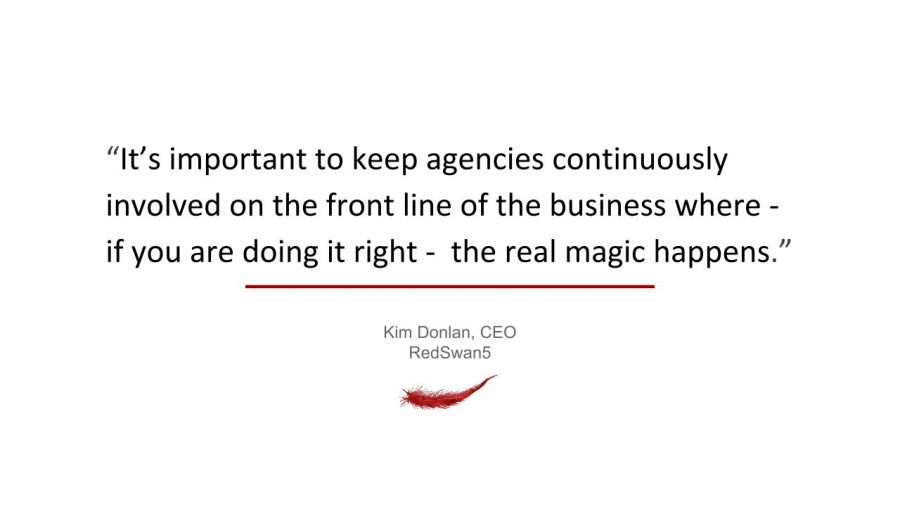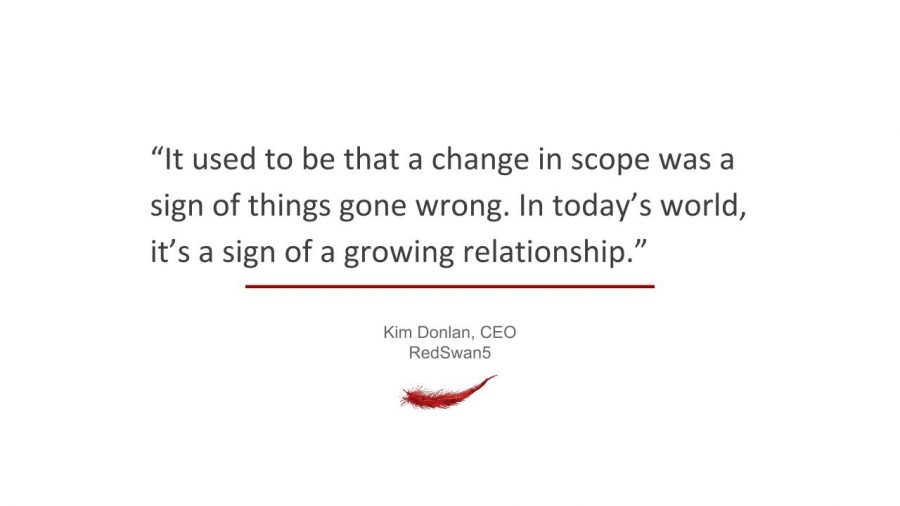
The client/agency relationship and business model are changing as each grapples with the best way to support rapid innovation in a digital age. Just as CMOs are being held more accountable for the business strategy and creating a complete customer experience, agencies are finding themselves tackling difficult assignments that require deep collaboration, total transparency and often an unclear idea what the final deliverable should be. One thing is clear: the old (and some current) ways of doing things just aren’t working and a new path is something clients and agencies need to forge together.
At RedSwan5, our unique approach is working and we offer our insights into what is working.
1. Rethink the Discovery Process
Your client’s problems will not be solved by a single creative marketing campaign or a new website. Organizations face complex business problems that must be understood to make a true impact on the business. It is important to investigate internal issues that have hurt the client in the past and to have insight into how your work will contribute revenue or impact operations.
According to Leslie Collins, executive director of DiscoverE.org, “An open dialogue at the very beginning of the assignment about how we get in our own way allowed us to acknowledge when it happened — and course correct when we needed to.”
At the start, both clients and agencies should know:
- What internal processes will get in the way
- Who should really be part of decisions
- How the data might be collected and used
- What they wish would have happened when they’d done this in the past
- If everyone will be okay if the assignment changes based on what is collectively learned in the discovery phase
2. Embrace the Iterative Design Process
Forget counting revision cycles and restricting feedback — a better model allows for collaboration around an objective that is tied to a timeframe. With the objective clearly established, design decisions can be prioritized based on how well they fit the objective. If they do not, they can fall lower on the list or be addressed in subsequent work.
In order to successfully embrace this process, both client and agency must agree to:
- Remain focused on the agreed objective
- Start with prioritized requirements that tick and tie to the objective
- Prioritize design ideas and functionality based on requirements
- Limit the time frame so work can be managed and delivered
- Address related items later if they do not directly support the objective

3. Get to the MVP (Minimum Viable Product) or Prototype Fast
Gathering feedback from potential early users is the best and fastest way to test beliefs and requirements. An MVP is also a way to screen for user experiences that may be based on potential client bias. Real users clicking through actual designs that demonstrate the user flow teach both the agency and the client what customers are willing to pay for.
“It is more productive and far more gratifying to be collaborating with all the right people in the room focused on a single objective, without worrying about getting it perfect right out of the gate.”
— Darryl Settles, Catalyst Ventures Development
Before finalizing design or spending big on development, use click-through prototype tools like Invision, Optimal Workshop, JustInMind or even a presentation application with links to verify your assumptions.
The tools can be used to:
- Gain valuable market intelligence
- Tease out the real competitive differentiator
- Attain additional funding and support
- Prove the concept
4. Remember: Change (of Scope) Is a Good Thing
It used to be that a change of scope was a sign of things gone wrong. In today’s world, it is a sign of a growing relationship. RFPs or scopes of work (SOW) written before the collaborative thinking and discovery (steps 1 through 3 above) will never fully capture what ultimately needs to be delivered.
There will be a more refined project plan based on the discovery phase findings and results of user testing and feedback. It may be a more elaborate scope of work or, in some cases, a fundamentally different project altogether. In fact, it could even mean a decision to not pursue the project at all — a shiver-inducing prospect for many agencies.
“As part of the branding process, you reach several forks in the road where you need to select the right path. Sometimes, the best decision is to not move forward – or go in a completely different direction. It takes the right agency relationship and very competent people to choose it.”
— Andrew Boyd, former CMO, Dimensional Insight
The truth of the matter is that what is best for the client and their customers is best for the agency. If the scope is bigger, smaller, different, difficult, uncomfortable, exciting or simply out of your wheelhouse, it is an opportunity for both the agency and the client to continue to build a relationship based on trust.
Often this re-scope will:
- Build a foundation for a long-term relationship
- Lead to a larger project
- Support new partnerships or extend the service offering
5. Propose Alternative Budgeting and Payments
Introducing new models of collaborative, iterative cycles means that controlling costs can be very hard for both agencies and clients. Restricting hours in the discovery phase can end up costing far more in development when a feature is more difficult than originally thought.
Budgets and pricing models can be adapted to the work effort. It is perfectly acceptable to have different models for each phase of the project. The most important issue is to discuss pricing and payment plans based on what is required for each phase — and acknowledge that one size or price does not fit all — and mixing the models for different phases of the engagement is actually appropriate. For example, the discovery phase might use a consulting model while development is a fixed cost.
For the agency and client relationship to improve, both sides must be open to a better way of working together. This relationship needs to be based on a stronger connection, transparency and trust. It is imperative that agencies understand the client’s full business problems and are able to listen to and embrace the internal client hurdles while focusing on developing an external solution. It is important for clients to keep agencies continuously involved on the front line of the business where (if you are doing it right) the real magic happens.